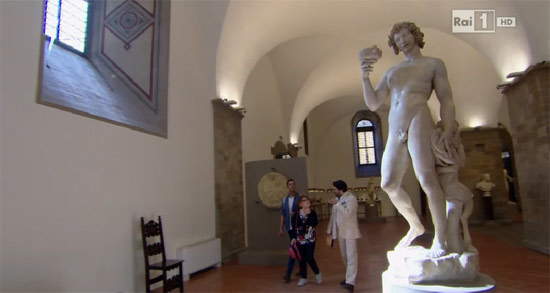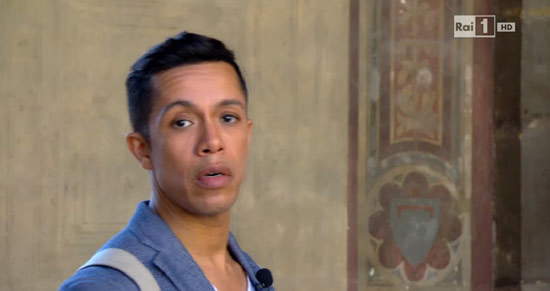by Federico Giannini (Instagram: @federicogiannini1), published on 04/07/2016
Categories: News Focus
/ Disclaimer
RAI entrusts Costantino D'Orazio with the popularization of art history in the program 'Travelling with Auntie'. And he makes mistakes as his usual.
For those accustomed to watching some art history on TV, the figure of Costantino D’Orazio will certainly not constitute news. On the other hand, for those who are not familiar with him, this is a ubiquitous character whose role is to popularize art history: his TV and radio forays go from Geo & Geo to #staiserena up to the latest RAI-branded travel program, In viaggio con la zia, with Syusy Blady and Livio Beshir. On the program, Costantino D’Orazio intervenes whenever a work of art is mentioned. The problem is that he often does so out of turn, exhibiting embarrassing sequences of inaccuracies and even egregious errors that obviously bring down the quality level of the program. And this is a pity, because the program is very well done: the presenters are knowledgeable, lively and never boring, the travels focus mainly on unforeseen and often little-known places, and there are many opportunities to discover interesting details.
It is therefore a pity that, for the part of the art-historical popularization, the production decided to turn to a character whose lack of familiarity with the subject is well known. In the program he conducted for RAI, AR. Fragments of Art, the series of errors is long and has already been discussed, but one could continue with his appearances on Geo & Geo (in an episode in which he talked about Botticelli’s Venus, D’Orazio had gone so far as to say that the Florentine artist had been inspired by the Capitoline Venus... perhaps forgetting that the statue was actually found around 1670, some two hundred years after Botticelli’s masterpiece was made) and, of course, with his interventions in In viaggio con la zia. Making the list of errors in the episode in which Blady and Beshir are in Turin was taken care of by the blog Sul Parnaso with a post on its Facebook page, but errors and inaccuracies also abound in the first installment of the series, dedicated to the city of Florence. Here are the results D’Orazio managed to achieve in just a few minutes of broadcasting:
 |
| Livio Beshir, Syusy Blady and Costantino D’Orazio with Michelangelo’s Bacchus |
- Regarding Leonardo da Vinci’s famous drawing that depicts Bernardo Bandini Baroncelli, one of the participants in the Pazzi conspiracy, being hanged, Costantino D’Orazio says that it was a study for a later realization to be painted “on the facade of a palace”: according to the TV personality’s reconstruction, the commission was later given to Sandro Botticelli by Lorenzo the Magnificent, an episode that allegedly caused Leonardo’s deep disappointment. In fact, Leonardo’s drawing dates back to 1479 (Bandini Baroncelli was hanged on December 29, 1479 from a window of the Palazzo del Bargello, and not in the present Piazza della Signoria, as D’Orazio would have us believe by asserting that Leonardo was actually in that square taking notes), while the commission to depict traitors in an infamous fresco was given to Botticelli a year earlier, in the summer of 1478, by the Otto di Guardia e Balia, an ancient Florentine magistracy that dealt with crime and security. Some scholars have speculated that Leonardo’s drawing was executed with a view to a later realization than Botticelli’s (and perhaps precisely with the deliberate intent of procuring a commission, perhaps that of adding a figure to Botticelli’s fresco), but we cannot establish this with certainty, because there are no documents that can link Botticelli’s work to Leonardo’s drawing, or that otherwise tell us of a possible destination for Leonardo’s sheet.
- Costantino D’Orazio states that Michelangelo’s Bacchus would have been rejected by the client on the grounds that the artist depicted him inebriated, contrary to the expectations of the client, who wanted a god depicted in a classical pose. We do not actually know the reasons why the client, the powerful Cardinal Raffaele Riario, did not accept the work, which was later purchased by the banker Jacopo Galli. D’Orazio takes for granted the hypothesis that Riario did not like the way Michelangelo depicted the god: it is plausible, but it is certainly not the only answer to the problem, and to present it as if it were an absolute certainty is to make a less than serious disclosure because, however much the popularizer may lean toward one position, he is still not exempt from the task of presenting to those who follow him all the other plausible hypotheses (or at least the main ones) as well. The range, in fact, is not so narrow, and the hypothesis to which D’Orazio gives credence is, by the way, the oldest, because it goes back more or less to the time of the publication (which took place in 1981) of the documents attesting to the commission by the cardinal. Since then, several have tried to propose a solution to the problem: perhaps, quite simply, the work did not appeal to the cardinal (Paola Barocchi, 1982), or there was a loss of interest in the work on the part of the cardinal (Christoph Frommel, 1997, who also offers another solution: perhaps the place that was to house the sculpture was not yet ready). And again: the reason could have been the client’s disappointment at seeing that the work did not meet his standards (Ingrid Drake Rowland, 1998), the fact that such a work was unbecoming of a cardinal’s collection (William E. Wallace, 2010), or an altercation between Raphael Riario and Michelangelo (Michael Hirst, 2011), or even the fact that the changed political conditions in Rome in 1497 after the assassination of Giovanni Borgia, which was followed by a spiritual crisis of Pope Alexander VI, who set out to combat the vices of the Church (resolutions, however, short-lived), had prompted Raphael Riario to consider it unprudent to display a statue that of the aforementioned vices was a clear symbol (Erin Sutherland Minter, 2013). And in any case, as can be seen, the most recent hypotheses are in agreement in discarding the hypothesis that the cardinal was unhappy with the sculpture, who paid payments to the artist until the end of the work (a sign that he must not have been all that unhappy with the sculpture). In short: the reality is much more complex than Costantino D’Orazio would have the viewer believe. Given the little space given to the work in the broadcast, we might as well gloss over the issue and focus on other aspects.
- Proceeding to Michelangelo’s Room at the Bargello Museum, D’Orazio, Blasy and Beshir linger for a few seconds in front of Jacopo Sansovino’s Bacchus, and the “professor” (the appellation the two presenters address to our “popularizer”) presents the work as a “Bacchus realized in a classical and consonant manner.”.. too bad that he forgets to say who the real author is, and in a context in which we speak exclusively of Michelangelo we run the risk of making the viewer believe that Sansovino’s Bacchus is also the work of Michelangelo. Perhaps D’Orazio knows who the author of the work is, but keeping silent about the author while talking only about Michelangelo is still a naivety that should not appear on a RAI program.
- Finally, Costantino D’Orazio manages to confuse Michelangelo’s David-Apollo with an improbable (and nonexistent) “David-Bacco” (sic!) dragging even poor Livio Beshir into error.
Of course: we are convinced that everyone can make mistakes, and that there are no works of popularization entirely free from the risk of inaccuracies. Mistakes, in short, are part of the job, and serve to constantly improve. But on the other hand, we wonder how it is possible for RAI to continue to rely on a character who has demonstrated on several occasions to offer very poor quality indeed, to repeatedly make even trivial and naive mistakes (which one really would not expect from a “professor” of art history), and to continue to trivialize complex issues such as the one we have highlighted in the second point in the list above. Of course, we have nothing against Constantine D’Orazio, who, moreover, on the occasions when he has publicly responded to criticism has shown an elegance that is not for everyone. Our disappointment is against the sufficiency with which the matter is treated. It is a matter of professionalism.
Finally, allow me an ironic note. Livio Beshir’s low tolerance for the “professor” (although it is, unfortunately, stage fiction) is widely shared by all art history lovers. His face, which is already beautiful in its own right, becomes marvelous at the moment of Costantino D’Orazio’s entrance to the Bargello Museum, commented by Beshir with an annoyed"n’ata vota." Which is then the comment of everyone who cares about art history and sees that, for the umpteenth time, the part of the popularizer of art history has gone to Costantino D’Orazio. N’ata vota.
 |
| Livio Beshir’s face at the moment of Costantino D’Orazio’s entrance. |
Warning: the translation into English of the original Italian article was created using automatic tools.
We undertake to review all articles, but we do not guarantee the total absence of inaccuracies in the translation due to the program. You can
find the original by clicking on the ITA button. If you find any mistake,please contact us.

